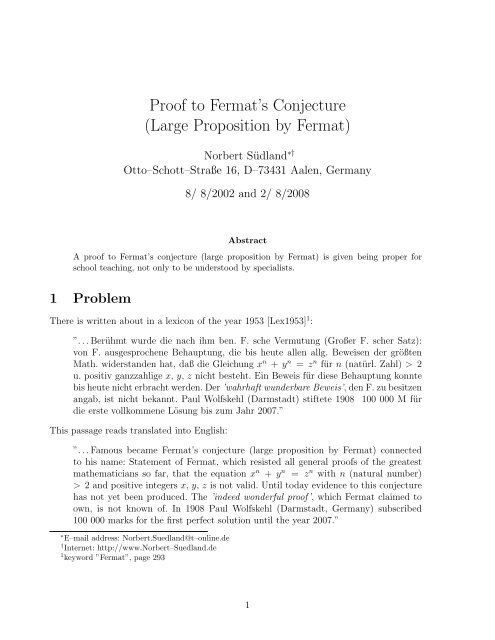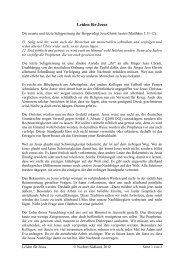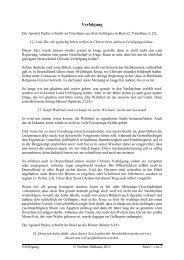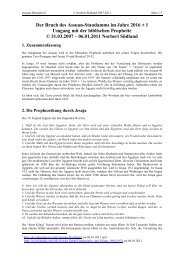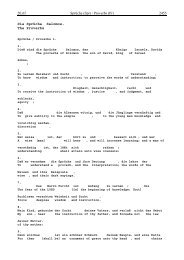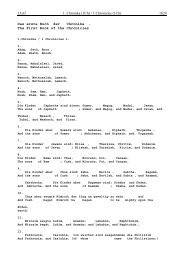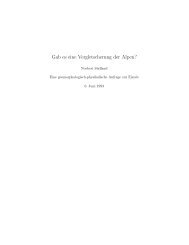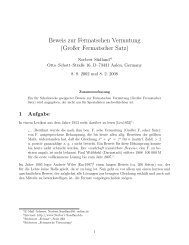Proof to Fermat's Conjecture (Large Proposition ... - Norbert Südland
Proof to Fermat's Conjecture (Large Proposition ... - Norbert Südland
Proof to Fermat's Conjecture (Large Proposition ... - Norbert Südland
Create successful ePaper yourself
Turn your PDF publications into a flip-book with our unique Google optimized e-Paper software.
<strong>Proof</strong> <strong>to</strong> Fermat’s <strong>Conjecture</strong><br />
(<strong>Large</strong> <strong>Proposition</strong> by Fermat)<br />
<strong>Norbert</strong> <strong>Südland</strong> ∗†<br />
Ot<strong>to</strong>–Schott–Straße 16, D–73431 Aalen, Germany<br />
8/ 8/2002 and 2/ 8/2008<br />
Abstract<br />
A proof <strong>to</strong> Fermat’s conjecture (large proposition by Fermat) is given being proper for<br />
school teaching, not only <strong>to</strong> be unders<strong>to</strong>od by specialists.<br />
1 Problem<br />
There is written about in a lexicon of the year 1953 [Lex1953] 1 :<br />
”. . . Berühmt wurde die nach ihm ben. F. sche Vermutung (Großer F. scher Satz):<br />
von F. ausgesprochene Behauptung, die bis heute allen allg. Beweisen der größten<br />
Math. widerstanden hat, daß die Gleichung x n + y n = z n für n (natürl. Zahl) > 2<br />
u. positiv ganzzahlige x, y, z nicht besteht. Ein Beweis für diese Behauptung konnte<br />
bis heute nicht erbracht werden. Der ’wahrhaft wunderbare Beweis’, den F. zu besitzen<br />
angab, ist nicht bekannt. Paul Wolfskehl (Darmstadt) stiftete 1908 100 000 M für<br />
die erste vollkommene Lösung bis zum Jahr 2007.”<br />
This passage reads translated in<strong>to</strong> English:<br />
”. . . Famous became Fermat’s conjecture (large proposition by Fermat) connected<br />
<strong>to</strong> his name: Statement of Fermat, which resisted all general proofs of the greatest<br />
mathematicians so far, that the equation x n + y n = z n with n (natural number)<br />
> 2 and positive integers x, y, z is not valid. Until <strong>to</strong>day evidence <strong>to</strong> this conjecture<br />
has not yet been produced. The ’indeed wonderful proof’, which Fermat claimed <strong>to</strong><br />
own, is not known of. In 1908 Paul Wolfskehl (Darmstadt, Germany) subscribed<br />
100 000 marks for the first perfect solution until the year 2007.”<br />
∗ E–mail address: <strong>Norbert</strong>.Suedland@t–online.de<br />
† Internet: http://www.<strong>Norbert</strong>–Suedland.de<br />
1 keyword ”Fermat”, page 293<br />
1
In 1993 Andrew Wiles [Enc1997] 2 produced a large evidence (about 200 pages), <strong>to</strong>o long <strong>to</strong><br />
be presented in a lecture. Now a short and obvious proof is seeked containing all solutions of<br />
the equation, where just mathematical methods are used, that also might be known <strong>to</strong> Fermat<br />
himself.<br />
2 Solution by Simplification of the Problem<br />
2.1 Motivation<br />
The starting equation<br />
x n + y n = z n<br />
seems <strong>to</strong> have a form being proper <strong>to</strong> present the problem only.<br />
2.2 Aimed Transformation<br />
It is presented alternatively <strong>to</strong> get a difference of two power terms:<br />
(1)<br />
x n = z n − y n . (2)<br />
Then a division by y n takes place, where x > 0, y > 0, z > 0, and real n yields:<br />
� �n x<br />
y<br />
The right hand side can be interpreted as an finite geometrical series.<br />
2.3 Finite Geometrical Series<br />
=<br />
� �n z<br />
− 1. (3)<br />
y<br />
The finite geometrical series [BrS1987] 3 yields with natural (i.e. positive integer) n:<br />
q n − 1 = (q − 1)<br />
n − 1<br />
�<br />
µ = 0<br />
q µ . (4)<br />
The correctness of this relation is easy <strong>to</strong> calculate by use of a telescope sum:<br />
(q − 1)<br />
n − 1<br />
�<br />
µ = 0<br />
q µ =<br />
n − 1 + 1<br />
�<br />
µ = 0 + 1<br />
q µ −<br />
n� − 1<br />
q<br />
µ = 0<br />
µ = q n − 1. (5)<br />
By multiplication by yn the finite geometrical series (4) yields because of q = z<br />
y<br />
of the finite geometrical series:<br />
2 keyword ”Fermatsche Vermutung”, i.e. ”Fermat’s conjecture”<br />
3 section 2.3.2., page 114<br />
a generalization<br />
z n − y n n� − 1<br />
= (z − y) z<br />
µ = 0<br />
µ y n−1−µ . (6)<br />
2
By this is shown that a fac<strong>to</strong>r (z − y) exists often leading <strong>to</strong> a possible division of the equation<br />
(2) by (z − y) n , because of the unequivocalness of prime fac<strong>to</strong>r separation of integer numbers,<br />
if Fermat’s demand is valid. During the rest of the paper this fac<strong>to</strong>r is called b.<br />
If such a solution is found, it is possible <strong>to</strong> produce a lot of infinity further solutions of the<br />
same type, by multiplication of the solution type with a natural number powered n times.<br />
2.4 First Substitution of the Problem<br />
Thus the following substitution results, which transforms the equation of the three unknwon<br />
variables x, y, and z in<strong>to</strong> an equation with other three unknown variables x, y, and b:<br />
with the solution:<br />
z − y = b (7)<br />
z → y + b. (8)<br />
There is no alternative <strong>to</strong> problem (2), that can be found by substitution of the original sum (1),<br />
because the sum of two power terms cannot be simplified by use of the finite geometrical series.<br />
The substituted equation—compared <strong>to</strong> equation (2)—<br />
x n = (y + 1) n − y n<br />
is the path <strong>to</strong> the general solution for x, y, b, and n each being natural numbers.<br />
A further connection is needed leading <strong>to</strong> a further substitution and thus the general solution.<br />
2.5 Binomial <strong>Proposition</strong><br />
Fermat also worked <strong>to</strong>gether with Pascal [Lex1953] 4 , who elaborated the European form of the<br />
binomial proposition. Here it is:<br />
(a + b) n n�<br />
� �<br />
n<br />
= a<br />
µ<br />
µ b n−µ . (10)<br />
µ = 0<br />
The binomial coefficients � �<br />
n<br />
used here, build up the Chinese triangle [Oli1995] µ<br />
5 —in Europe also<br />
known as Pascal’s triangle[Lex1953] 6 —and fit for the following difference equation:<br />
� �<br />
n + 1<br />
µ + 1<br />
� � � �<br />
n n<br />
= + .<br />
µ µ + 1<br />
(11)<br />
Pascal was able <strong>to</strong> calculate each binomial coefficient directly by use of the fac<strong>to</strong>rial n! = �n µ = 1 µ<br />
with n being a non–negative integer number:<br />
� �<br />
n n!<br />
=<br />
. (12)<br />
µ µ! (n − µ)!<br />
An empty product yields number one thus the binomial coefficients are known and unequivocal<br />
for all arguments (needed here).<br />
4 keyword ”Pascal”, page 754<br />
5 section ”War Pascal Chinese?”, i.e. ”Was Pascal a Chinese person?”, page 102–105<br />
6 keyword ”Pascalsches (arithmetisches) Dreieck”, i.e. ”Pascal’s (arithmetic) triangle”, page 754<br />
3<br />
(9)
2.6 Transformation by the Binomial <strong>Proposition</strong><br />
Now the remaining problem (9) can unequivocally be simplified by the binomial proposition for<br />
all positive integers n in the following way:<br />
x n =<br />
n − 1<br />
�<br />
µ = 0<br />
� �<br />
n<br />
y<br />
µ<br />
µ . (13)<br />
The writing of sums according <strong>to</strong> Leibniz (1646–1716) [Lex1953] 7 came up later than Fermat<br />
(1601–1665) [Lex1953] 8 , but it is very useful <strong>to</strong> avoid the less clear style using dots, when producing<br />
an obvious evidence.<br />
2.7 Second Substitution of the Problem<br />
The problem yet <strong>to</strong> be solved (13) for positive integers n is also gotten when the n th ordered root<br />
of the integer sum is called x: This integer number x indeed is seeked for.<br />
The binomial proposition including the binomial coefficients is very unequivocal and a forcing<br />
form <strong>to</strong> get an n th ordered root without integer rest: The solution found must fulfil the binomial<br />
proposition anyway!<br />
The n th ordered power term of an integer value must be added <strong>to</strong> the sum thus the whole<br />
equation (9,13) can be added <strong>to</strong> −x n :<br />
0 = −x n − y n + (y + b) n . (14)<br />
A coefficient list based on the binomial proposition also in this form yields the connection<br />
<strong>to</strong> get a single power term of order n:<br />
−x n − y n = 0 (15)<br />
y n = −x n . (16)<br />
This determinative equation (16) also can be gotten directly from equation (13). Other possibilities<br />
are not included within the binomial proposition, there is just a possibility of special cases,<br />
which can be found before application of the second determinative equation (16).<br />
2.8 General Solution Triple<br />
The determinative equation (16) can be divided by x n <strong>to</strong> get n different roots of −1:<br />
y<br />
x = n√ −1 . (17)<br />
Because of i = √ −1 , these roots are not real for n being an even number.<br />
7 keyword ”Leibniz”, page 586<br />
8 keyword ”Fermat”, page 293<br />
4
For all n �= 0 there is the solution possibility y → 0 not being valid because zero is not a<br />
natural number.<br />
For odd n there is an additional solution possibility y → −x leading <strong>to</strong> z = y + b = 0.<br />
Thus there are three numbers in each case which solve the starting problem (after resubstitution):<br />
• x n + y n = z n with integer x, y → 0, z → x, and integer n �= 0;<br />
• x n + y n = z n with integer x, y → 0, z → −x, and even n �= 0;<br />
• x n + y n = z n with integer x, y → −x, z → 0, and odd n.<br />
All these solutions are not valid because of the demand that x, y and z are positive integer<br />
numbers. In each case the solutions can be multiplied by the n th power of an integer number,<br />
i.e. by w n , thus leading <strong>to</strong> a lot of infinity different solution triples (of the same type) for each<br />
integer n and x.<br />
Also here, number zero is an even number with 0 0 = 1, thus for n → 0 no solution is found.<br />
The solution has been found with most generality, thus further solutions of the problem can<br />
be found before both substitutions only. This must be looked at in detail depending on the<br />
parameter n.<br />
2.9 Further Solution Triples for n → 1<br />
For n → 1 results that the sum of two natural numbers is a natural number, <strong>to</strong>o:<br />
x + y = z. (18)<br />
This case is already valid at the beginning of the problem, thus excluded by Fermat explicitly.<br />
2.10 Further Solution Triples for n → 2<br />
For n → 2 after the first substitution (13) results the following view:<br />
x 2 = 2 y b + b 2<br />
On the right hand side for b → 1 there is an odd number. Odd square numbers exist, namely the<br />
squares of all odd numbers.<br />
Thus an algebraic solution in y is found for positive integers x:<br />
�<br />
x, y → x2 − b2 , z →<br />
2 b<br />
x2 + b2 �<br />
2 b<br />
=<br />
�<br />
x, y → x2<br />
2 b<br />
b x2 b<br />
− , z → +<br />
2 2 b 2<br />
�<br />
(19)<br />
. (20)<br />
Here, it is also remarkable that the first solution triple for x → b has got a zero number term.<br />
Solution examples:<br />
• b = 1: 5 2 − 4 2 = 3 2 , 13 2 − 12 2 = 5 2 , 25 2 − 24 2 = 7 2 , 41 2 − 40 2 = 9 2 , 61 2 − 60 2 = 11 2 , etc.<br />
• b = 2: 5 2 − 3 2 = 4 2 , 10 2 − 8 2 = 6 2 , 17 2 − 15 2 = 8 2 , 26 2 − 24 2 = 10 2 , 37 2 − 35 2 = 12 2 , etc.<br />
For b > 1 there are irreducible cases, thus b = 1 is not the case in general.<br />
5
Irreducible solution examples (for some b all cases are reducible) are:<br />
• b = 1: 5 2 − 4 2 = 3 2 , 13 2 − 12 2 = 5 2 , 25 2 − 24 2 = 7 2 , 41 2 − 40 2 = 9 2 , 61 2 − 60 2 = 11 2 , etc.<br />
• b = 2: 17 2 − 15 2 = 8 2 , 37 2 − 35 2 = 12 2 , 65 2 − 63 2 = 16 2 , 101 2 − 99 2 = 20 2 , etc.<br />
• b = 8: 29 2 − 21 2 = 20 2 , 53 2 − 45 2 = 28 2 , 85 2 − 77 2 = 36 2 , 125 2 − 117 2 = 44 2 , etc.<br />
• b = 9: 65 2 − 56 2 = 33 2 , 89 2 − 80 2 = 39 2 , 149 2 − 140 2 = 51 2 , 185 2 − 176 2 = 57 2 , etc.<br />
The irreducible solution examples mostly occur, if b is the square of a b, which already yielded<br />
irreducible cases. This is directly elucident, if the multiplica<strong>to</strong>r b = z − y of the finite geometric<br />
series (6) is looked at, which shall lead for n = 2 <strong>to</strong> a square number.<br />
Thus further cases are resulting, which can be overseen easily during the proof, if e.g. b = 1<br />
is set. The cases shown here may be enough <strong>to</strong> clarify, that in general b cannot be reduced <strong>to</strong><br />
one single number.<br />
Each solution type can be multiplied by a square number <strong>to</strong> get the complete solution of the<br />
problem. The case n → 2 has been excluded by Fermat, <strong>to</strong>o.<br />
For n = 2 can be concluded, that the seek for Pythagorean twins turns out <strong>to</strong> be as interesting<br />
and unexpected as the seek for prime numbers.<br />
2.11 Undecidable Problem?<br />
For n > 2 the right hand side of equation (13) consists of at least three terms. Therefore here<br />
for producing a power term the binomial proposition must be used.<br />
A remarkable unclearness results concerning this argumentation, thus by the supposition that<br />
Fermat’s proposition would be wrong, the following substitution seems <strong>to</strong> be helpful:<br />
x n → z n − y n<br />
In fact this is a resubstitution, the solution of which clearly leads <strong>to</strong> z = y + b without having<br />
proven anything by this. Therefore it is obviously not possible <strong>to</strong> prove Fermat’s proposition by<br />
a contradiction proof, but the following circumstance results:<br />
• If the proposition is valid, then the system is consistent.<br />
• If the proposition is invalid, then the system is also consistent.<br />
Here, the opinion that the supposition of the opposite would lead forcingly in<strong>to</strong> a contradiction,<br />
is very obviously erroneous, because for n = 2 Fermat’s proposition is quite wrong. This solution<br />
manifold however is also contained within the algebraic formulation (21). The opinion by Gödel<br />
<strong>to</strong> declare the problem <strong>to</strong> be undecidable 9 , therefor can be rejected: A blurred formulation does<br />
not tell anything, also not on the decidability itself.<br />
On Fermat’s proposition actually only the question is dealed with, at what point the binomial<br />
proposition must be used for integer numbers <strong>to</strong> complete an incomplete binomial sum. This is<br />
the case for integer n > 2.<br />
9 [Göd1931], footnote 61, page 196<br />
6<br />
(21)
2.12 Summary<br />
For this, the proposition by Fermat holds:<br />
”There are no natural (positive integer) numbers x, y, z, n with n > 2,<br />
that fulfil the equation x n + y n = z n .”<br />
This needed <strong>to</strong> be shown. (quod erat demonstrandum)<br />
2.13 Outlook<br />
For interested persons is mentioned, that the following cubic triplets exist:<br />
3 3 + 4 3 + 5 3 = 6 3 . (22)<br />
An analogous proof <strong>to</strong> the evidence of Fermat’s proposition takes place after a threefold substitution<br />
of an equation, containing four variables and a power order n. Someone might be less well<br />
aquainted with the theorems handling threefold sums.<br />
3 Discussion of Evidence<br />
3.1 Motivation<br />
The evidence given is alarming simple and comparatively concise. Doubts about completeness, especially<br />
in consideration <strong>to</strong> solutions forgotten eventually, are not removable entire unequivocally<br />
<strong>to</strong> each specta<strong>to</strong>r. For this, some further points of view shall be mentioned.<br />
3.2 Further Solution Triples with n > 2 ?<br />
3.2.1 How <strong>to</strong> do<br />
The seek for further special cases, like the ones already found before the determinative equation<br />
(16) with n → 2, keeps being famous. For this, now the algebraic orders are dealed with, that<br />
can be solved by the Cardanic formulas, yet:<br />
3.2.2 Solution for n → 3 and b → 1:<br />
The most simple case n → 3 and b → 1 yields:<br />
x 3 = 3 y 2 + 3 y + 1. (23)<br />
The cubic root of the integer term on the right hand side might be named x. With integer y this<br />
problem leads <strong>to</strong> the insight y 3 = −x 3 already dealed with.<br />
7
To deal analogous <strong>to</strong> the case n → 2, the following solutions for y are found now:<br />
y → − 1 1 √<br />
± 12 x3 − 3 . (24)<br />
2 6<br />
With x → 1 only, a square number is gotten as root term, leading <strong>to</strong> y → −1 and y → 0. Both<br />
possibilities already have been discussed.<br />
3.2.3 Solution for n → 4 and b → 1:<br />
The case n → 4 and b → 1 yields:<br />
The solution with root = 3�<br />
27 x 4 + 3 √ 81 x 8 + 3 is:<br />
y1 → 1<br />
�<br />
−3 −<br />
6<br />
3<br />
root<br />
x 4 = 4 y 3 + 6 y 2 + 4 y + 1. (25)<br />
�<br />
+ root<br />
, (26)<br />
y2,3 → 1<br />
⎛ �<br />
3 1 ± i<br />
⎝−3 +<br />
6<br />
√ 3 � �<br />
1 ∓ i<br />
−<br />
2 root<br />
√ 3 � ⎞<br />
root<br />
⎠ .<br />
2<br />
(27)<br />
A rational solution triple exists for x → 0 with root → √ 3 :<br />
y → − 1<br />
i<br />
, y → −1 ± . (28)<br />
2 2 2<br />
This special solution can be multiplied by 24 = 16, thus being an integer solution. The result is<br />
not new:<br />
2 4<br />
�<br />
0 4 �<br />
+ − 1<br />
�4<br />
2<br />
�<br />
= 2 4<br />
� �4 1<br />
.<br />
2<br />
(29)<br />
An integer number solution is found at the well–known position with x → ±1, where results<br />
root → 3�<br />
27 + 6 √ 21 , leading <strong>to</strong> y → 0.<br />
The theorems <strong>to</strong> simplify cubic roots are completed so weekly, that the solution must be<br />
found by use of numerical methods. The correct solution fulfils the following quadratic equation<br />
(26) in root anyway, and can be checked by this:<br />
The solution of this quadratic equation yields the identity:<br />
0 = 1<br />
�<br />
−3 −<br />
6<br />
3<br />
�<br />
+ root . (30)<br />
root<br />
root = 3�<br />
27 + 6 √ 21 = 3 + √ 21<br />
. (31)<br />
2<br />
The completeness of results already mentioned for even n stays valid.<br />
8
3.2.4 Solution for n → 5 and b → 1:<br />
For n → 5 and b → 1 results:<br />
The reduced polynomial in y → u − 1<br />
2<br />
The four solutions of equation (32) in y are:<br />
x 5 = 5 y 4 + 10 y 3 + 10 y 2 + 5 y + 1. (32)<br />
is biquadratic only:<br />
x 5 = 5 u 4 + 5<br />
2 u2 + 1<br />
. (33)<br />
16<br />
y → − 1<br />
2 ±<br />
�<br />
−5 ± 2 √ 20 x5 + 5<br />
2 √ 5<br />
. (34)<br />
Here, just square roots occur in the result, stressing that x → 1 entirely sure is the only integer<br />
solution:<br />
y1 = 0 y2 = −1 y3,4 = − 1<br />
√<br />
3<br />
± i . (35)<br />
2 2<br />
These results are not new, but stress <strong>to</strong> critics the completeness of the given evidence.<br />
3.3 Can Impossibility be Proven by Mathematics?<br />
The proof of impossibility given by Fermat mainly consists in the evidence of a zero number,<br />
thus not three, but two numbers only would really be seeked for. Fermat correctly decided <strong>to</strong><br />
avoid this ambiguousity by the precondition <strong>to</strong> seek for natural (positive integer) numbers only.<br />
If really three numbers are seeked for, there exist solutions, but at least as irrational numbers.<br />
Handling evidence of impossibility always needs special care, because much <strong>to</strong>o probable the<br />
one or other case might be overseen.<br />
Algebraic equations of nth order contain maximally n different solutions. This property can<br />
e.g. be used <strong>to</strong> give the n different roots of number one concretely.<br />
The nth roots of number one are exp � �<br />
2 i π µ<br />
with µ ∈ {0, 1, 2, 3, . . . , n − 1}. There are always<br />
n<br />
n roots (of order n) of number one. With this, the fundamental proposition of algebra can be<br />
proved, showing that because of the transformation type<br />
y n n� − 1<br />
= −<br />
µ = 0<br />
a(µ) y µ<br />
a normalized polynomial of degree n can result just n roots of a single complex number only,<br />
also for any complex kind of polynomial coefficients a(µ). To solve an algebraic equation means<br />
<strong>to</strong> be able <strong>to</strong> combine lower ordered roots <strong>to</strong> an unequivocal complex number term in each case<br />
(of order).<br />
9<br />
(36)
The fundamental proposition of algebra also can be given for natural n in the form:<br />
”It is impossible <strong>to</strong> get more than n roots from a polynomial of degree n.”<br />
In reality this proposition proofs the existence of n complex roots, that at least partially might<br />
be the same.<br />
As a consequence of this consideration can be formulated, that impossibility should be discussed<br />
as being proved only, where the properties of solution method or solution itself are known<br />
so much, that they do not fit <strong>to</strong> the given method or solution range (e.g.: natural numbers).<br />
Evidence of impossibility never should be unders<strong>to</strong>od in a way, that a surprisingly occuring<br />
possibility of solution is fighted against. Such occurences rather contribute <strong>to</strong> a healthy shock of<br />
whole thinking systems <strong>to</strong> free them from fallacies.<br />
This treatise shall help <strong>to</strong> grade a long missed evidence anyway <strong>to</strong> be easy. The author (not<br />
the most intelligent) needed twelve years <strong>to</strong> get a breakthrough <strong>to</strong> this amazing simple proof,<br />
and almost further six years <strong>to</strong> the understand the result.<br />
3.4 Tips on Producing Evidence<br />
If subgroups of complex numbers are mentioned in a proposition explicitly, the following connections<br />
are helpful with a trial of proof:<br />
• Algebraic transformation mostly is valid with complex terms.<br />
• Only rational power orders so far yield several roots (according <strong>to</strong> the denomina<strong>to</strong>r of the<br />
canceled fraction of power order), for real power orders p there are −[−|p|] 10 roots.<br />
• Prime fac<strong>to</strong>r separation is unequivocal <strong>to</strong> real integer numbers only. 11<br />
• A lot of mathematical propositions and transformations are valid for subgroups of the<br />
complex numbers only.<br />
• Real integer numbers are either even or odd, irrational real numbers like √ 2 are neither<br />
nor.<br />
4 Acknowledgments<br />
This work was not supported by any sponsor thus it is a free public domain according <strong>to</strong> German<br />
GG, Art. 5. The author thanks Mister Andreas Kempf (Bad Schussenried) for the correction of<br />
a hurdle of insight, and Mister Professor Dr. Bodo Volkmann (Stuttgart) for the tip concerning<br />
the irreducible cases for b > 1.<br />
10 The Gaussian bracket function [z] yields the next lower integer number [z] ≤ z.<br />
11 e.g. 2 = (1 + i) (1 − i) is not a prime fac<strong>to</strong>r separation, is it?<br />
10
A Unequivocalness of Euler’s Gamma Function<br />
The terms of Euler’s Gamma function Γ(n) interpolate the fac<strong>to</strong>rial formula n! = Γ(n + 1) and<br />
fit for the following difference equation:<br />
Γ (n + 1) = n Γ (n) . (37)<br />
Because of the reflection formula (being valid for all complex valued z)<br />
Γ (z) Γ (1 − z) =<br />
π<br />
,<br />
sin (π z)<br />
(38)<br />
Euler’s Gamma function fulfils the scanning theorem [Mar1986] 12 :<br />
”The minimal periode of the interpolating function is greater than or equal <strong>to</strong> the<br />
double distance of equidistant data points,”<br />
thus a main solution [Mes1959] 13 of the difference equation (37) is found—here the distance<br />
number one between integer numbers is used:<br />
π<br />
sin (π z) =<br />
π<br />
. (39)<br />
sin (π (z ± 2))<br />
The minimal periode of this product indeed is number two.<br />
By this, the Γ (z) function cannot own a periode less than number two, thus interpolating<br />
the fac<strong>to</strong>rial formula z! = Γ (z + 1) with best fit for all complex z.<br />
Thus equation (11) is also valid for any complex n and µ.<br />
References<br />
[BrS1987] Bronstein I. N., Semendjajew K. A., Taschenbuch der Mathematik, common edition<br />
of Nauka, Moskow and BSB B. G. Teubner Verlagsgesellschaft Leipzig, 23rd edition,<br />
(1987)<br />
[Enc1997] Microsoft(R) Encarta(R) 98 Enzyklopädie, German version, Microsoft Corporation,<br />
(1997)<br />
[Göd1931] Gödel K., Über formal unentscheidbare Sätze der Principia Mathematica und verwandter<br />
Systeme I, Monatshefte f¨r Mathematik und Physik (38), (1931), 173–198<br />
[Lex1953] Lexikon A-Z in einem Band, VEB Bibliographisches Institut Leipzig, (1953)<br />
[Mar1986] Marko H., Methoden der Systemtheorie, Springer Verlag Berlin etc., 2nd revised<br />
edition, (1986)<br />
[Mes1959] Meschkowski H., Differenzengleichungen, Vandenhoeck & Ruprecht Göttingen,<br />
(1959)<br />
[Oli1995] Olivastro D., Das chinesische Dreieck, Droemersche Verlagsanstalt Th. Knaur<br />
Nachf., Munich, (1995)<br />
12 section 6.1, pages 130–131<br />
13 section III, footnote at page 41<br />
11


